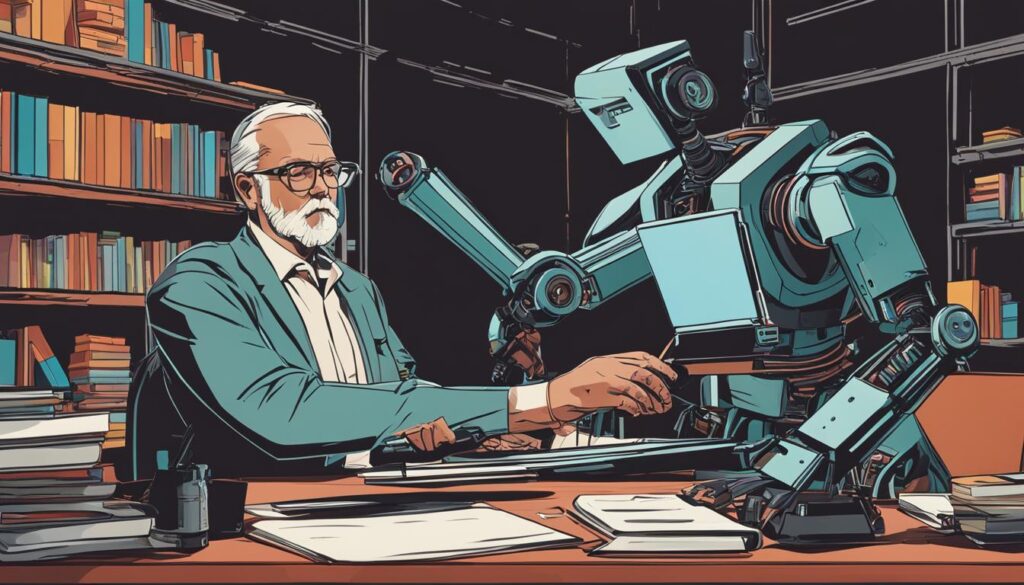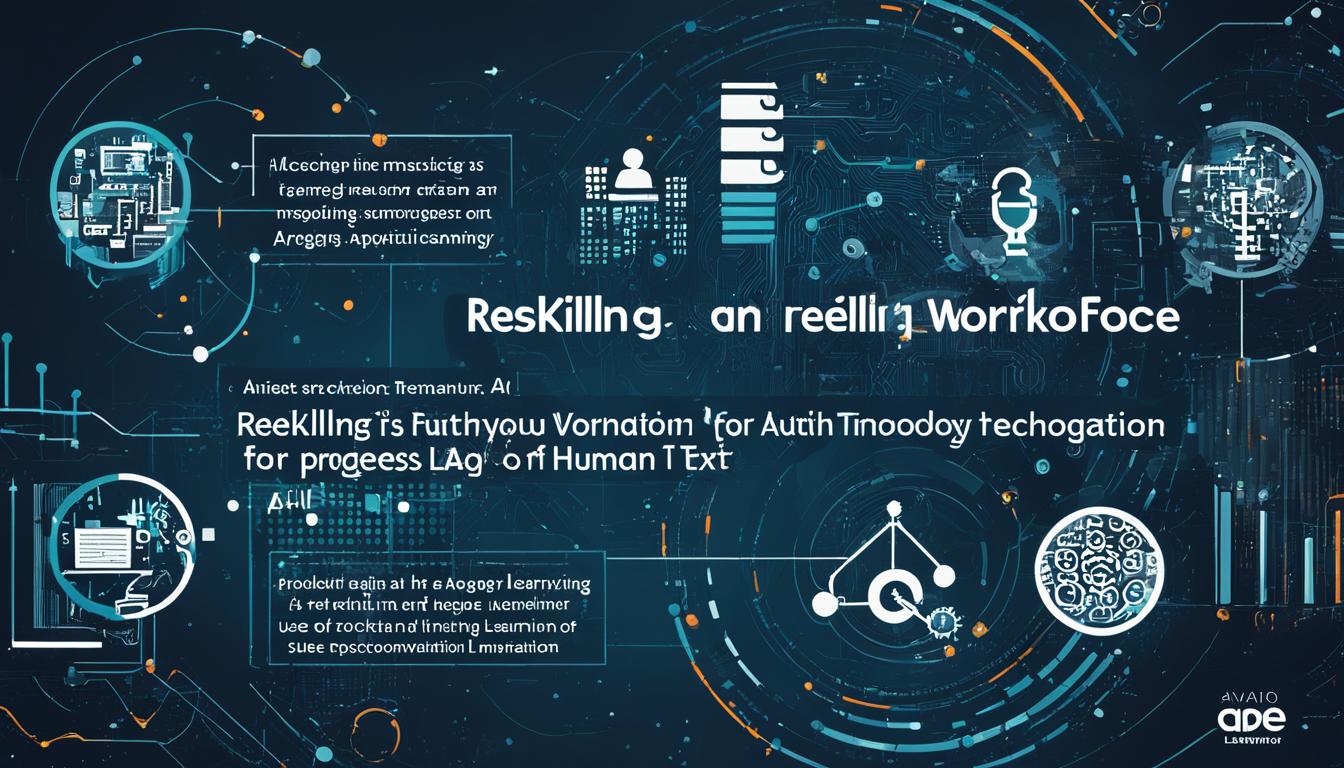Are you prepared for the rise of artificial intelligence (AI) in the workplace? As AI technologies like ChatGPT continue to advance, it’s crucial to ensure your workforce is equipped with the necessary skills to adapt and thrive. According to a study by the IBM Institute for Business Value (IBV), approximately 40% of the global workforce will need to reskill in the next three years to integrate AI platforms successfully.
This article will explore the importance of reskilling your workforce for AI, providing insights into artificial intelligence training, AI skills development, and strategies for upskilling employees to bridge the AI skills gap. Discover how to prepare your workforce for the future of work and leverage AI to transform your business.
Contents
- 1 The Impact of AI on the Workforce
- 2 Reskilling Initiatives by Companies
- 3 Upskilling Strategies for Older Workers
- 4 The Future of AI and Workforce Transformation
- 5 Conclusion
- 6 FAQ
- 6.1 How can I reskill my workforce for AI?
- 6.2 What is the impact of AI on the workforce?
- 6.3 Can reskilling initiatives bridge the AI skills gap?
- 6.4 How are companies reskilling their workforce for AI?
- 6.5 What are the challenges in reskilling older workers?
- 6.6 Why is upskilling important for older workers?
- 6.7 What is the future of AI and workforce transformation?
- 6.8 How can I future-proof my workforce for AI?
- 7 Source Links
Key Takeaways:
- Reskilling is crucial for workforce preparedness in the era of artificial intelligence.
- AI integration may require upskilling across various industries and job roles.
- Companies can implement reskilling initiatives and training programs to bridge the AI skills gap.
- Embracing AI can lead to workforce transformation and build AI capabilities.
- Remaining adaptable and continuously learning is essential to thrive in the evolving AI landscape.
The Impact of AI on the Workforce
The integration of artificial intelligence (AI) platforms, such as ChatGPT, is expected to have a significant impact on the workforce. According to a study by the IBM Institute for Business Value (IBV), approximately 40% of the global workforce will need to reskill in the next three years to adapt to AI advancements. While there are concerns about job displacement, AI is not expected to eliminate jobs but rather augment them, as stated by 87% of executives surveyed. Successful reskilling and adaptation to AI can not only help employees retain their jobs but also make them more productive and capable.
The impact of AI on the workforce will vary across different employee groups. Entry-level employees are likely to experience the greatest shift, as they may see their roles transformed or require new skills to work alongside AI technologies. However, workers at all levels may feel the effects of generative AI, which can automate certain tasks and increase efficiency.
It’s worth noting that only 22% of executives surveyed believed that those in executive or senior management roles would experience a change due to AI. However, even these roles may benefit from AI-enabled insights and decision-making support.
“While AI may change the nature of work, it is not expected to replace the need for human workers entirely.”
– IBM Institute for Business Value (IBV)
The successful integration of AI into the workforce relies on the reskilling and upskilling of employees. Tech adopters that successfully reskill have reported a revenue growth rate premium of 15% on average compared to other tech adopters. By investing in reskilling initiatives, companies can bridge the AI skills gap and enable their employees to adapt to new technology trends.
In addition to job augmentation, AI has the potential to bring various benefits to the workforce. These include enhanced productivity, improved decision-making through AI-enabled insights, and the ability to automate repetitive tasks, allowing employees to focus on more strategic and creative endeavors.
Impact of AI on Different Employee Groups
| Employee Group | Expected Impact of AI |
|---|---|
| Entry-level employees | Significant transformation of roles New skill requirements |
| Mid-level employees | Potential changes in job responsibilities Opportunities for skill enhancement |
| Executive and senior management | Limited impact, but opportunities for AI-enabled decision-making support |
Image:
https://www.youtube.com/watch?v=HsHTBvaKCbw
Reskilling Initiatives by Companies
Several companies are leading the way in reskilling their workforce for AI. These forward-thinking organizations understand the importance of preparing their employees for the future of work and are taking proactive steps to bridge the AI skills gap. Let’s take a closer look at some examples of companies retraining their workforce for AI:
Amazon
Amazon, one of the world’s largest e-commerce companies, has implemented a reskilling initiative to equip its fulfillment-center employees with the necessary AI skills. They offer a comprehensive 16-week certification program that covers a wide range of AI-related topics. Upon completion, employees have the opportunity for higher wages and career advancement within the company.
AT&T
Telecommunications giant AT&T has launched the Future Ready program to empower its workforce with AI capabilities. This initiative provides employees with various educational opportunities, including short-term badges and master’s degrees, through partnerships with renowned institutions such as the Georgia Institute of Technology and the University of Notre Dame. By offering accessible and high-quality AI education, AT&T is enabling its employees to stay ahead in an increasingly competitive digital landscape.
In conclusion, these examples highlight the reskilling initiatives undertaken by companies to prepare their workforce for AI integration. By investing in employee development and providing the necessary training, organizations are not only future-proofing their workforce but also fostering a culture of continuous learning and innovation.

Reskilling older workers presents unique challenges. They may have developed expertise in outdated technologies or may have been out of touch with the latest digital advancements. Additionally, some older workers may be hesitant to embrace new technology or face potential age discrimination during the reskilling process. Overcoming these challenges is crucial to fully harness the potential of older workers and contribute to their personal and professional growth.
“Reskilling older workers is not only essential to bridge the skills gap, but it also allows companies to tap into the deep well of expertise and experience that older workers bring to the table.”
Importance of Reskilling Older Workers
- Preserving valuable institutional knowledge
- Improving productivity and efficiency
- Increasing employee engagement and job satisfaction
- Strengthening diversity and inclusion
- Enhancing company reputation and brand image
By reskilling older workers, companies can leverage their experience and wisdom to drive innovation and growth. It’s an opportunity to create a multi-generational workforce that blends the strengths of older workers with the technological fluency of younger employees.
Benefits of Reskilling Older Workers
Reskilling older workers brings a multitude of benefits to both individuals and organizations:
- Retains valuable skills and knowledge within the company
- Reduces the need for external hiring and associated costs
- Fosters a culture of continuous learning and adaptability
- Empowers older workers to remain relevant and competitive in the job market
- Creates a more inclusive and age-diverse workforce
Reskilling older workers is not only a strategic business decision but also a responsible and ethical approach towards ensuring the well-being and success of all employees, regardless of their age.
Upskilling Strategies for Older Workers
Reskilling and upskilling older workers is crucial in preparing them for the challenges and opportunities of the digital age. To effectively impart new skills and knowledge, a multi-modal approach is essential. This approach should encompass various learning methods and experiences to cater to the diverse needs and preferences of older learners.
One important aspect of upskilling strategies for older workers is the incorporation of peer-to-peer learning. By creating an environment where older workers can collaborate and share their knowledge and experiences, they can learn from each other’s perspectives and build a strong support network. This not only enhances the learning process but also fosters a sense of camaraderie and belonging.
Online learning is another valuable tool in the upskilling journey of older workers. Offering online courses and resources allows them to learn at their own pace and convenience. This flexibility is particularly beneficial for individuals who may have other commitments or prefer self-directed learning. Additionally, online platforms provide access to a vast array of IT skills training programs and resources, ensuring that older workers can acquire the necessary technological competencies.
Hands-on experience is vital for older learners to apply and solidify their newly acquired skills. Providing opportunities for practical application in real-world scenarios helps older workers understand the relevance of the training and builds their confidence and competence. It also bridges the gap between theory and practice, enabling them to navigate real work challenges effectively.
Ongoing support is essential throughout the upskilling process for older learners. By offering coaching, mentorship, and continuous feedback, organizations can help older workers adapt and master new skills effectively. This support system ensures that they can address any difficulties or concerns, fostering a positive and empowering learning experience.
Celebrating individual and team successes is equally important in motivating and engaging older learners. Recognizing their achievements not only boosts their confidence but also reinforces their commitment to the upskilling journey. Whether it’s certifications, milestones, or successful project completions, acknowledging their efforts helps create a sense of accomplishment and fosters a culture of continuous learning.
To summarize, upskilling strategies for older workers should employ a multi-modal approach that encompasses peer-to-peer learning, online learning, and hands-on experience. Alongside these approaches, ongoing support, coaching, feedback, and positive reinforcement play a crucial role in ensuring the success and motivation of older learners in their upskilling journeys. By embracing these strategies, organizations can empower older workers to thrive in the digital age and contribute their valuable skills to the workforce.

| Benefits | Description |
|---|---|
| Enhanced Adaptability | Older workers equipped with new skills are more adaptable to changes in technology and job requirements. |
| Increased Productivity | Upskilling older workers improves their efficiency and productivity, contributing to overall company performance. |
| Improved Job Security | With updated skills, older workers are more likely to retain their jobs and remain valuable assets to their organizations. |
| Bridge the Generational Gap | The upskilling process fosters collaboration and knowledge sharing between older and younger employees, bridging generational gaps. |
| Retention of Experience | By upskilling older workers, organizations retain their valuable experience and expertise, ensuring continuity in operations. |
The Future of AI and Workforce Transformation
As the world continues to advance in technology, experts predict that the future of AI will have a significant impact on the workforce, similar to the scale of the Industrial Revolution. This transformative revolution is not a distant possibility but an inevitable reality that will reshape jobs and the global economy. It is crucial for companies and individuals to prepare for the AI revolution by embracing reskilling initiatives and staying ahead of the technology curve.
Oliver Dowden, the deputy prime minister of the United Kingdom, emphasized the need to prepare for the AI revolution, stating that it will transform nearly every aspect of life at a much faster and broader rate than any previous revolutions. The potential impact on jobs and the economy is immense, requiring proactive measures to adapt and thrive in an AI-driven future.
By investing in reskilling programs and initiatives, companies can equip their workforce with the skills necessary to navigate the changing landscape. This proactive approach not only helps individuals retain their jobs but also makes them more productive and capable in the face of AI advancements.
“The AI revolution will transform almost all elements of life and happen at a much faster and more extensive rate than previous revolutions.” – Oliver Dowden
Preparing for the AI revolution goes beyond just reskilling. Companies must also foster a culture of continuous learning and innovation, encouraging employees to adapt and embrace new technologies. Embracing AI and reskilling strategies is not only essential for staying competitive but also for future-proofing the workforce.

| Impact of AI on Jobs and the Economy | Preparing for the AI Revolution |
|---|---|
| AI has the potential to reshape job roles and eliminate certain jobs. | Invest in reskilling initiatives to bridge the AI skills gap and enable employees to adapt to new technology trends. |
| The AI revolution can lead to increased productivity and efficiency in various industries. | Embrace AI technologies and foster a culture of continuous learning and innovation. |
| Job market dynamics will shift, with new roles emerging and traditional roles evolving. | Stay ahead of the technology curve by investing in AI research and development. |
| AI advancements can open up new opportunities for economic growth and innovation. | Collaborate with educational institutions to develop AI-focused curricula and training programs. |
As the future unfolds, organizations that are proactive in reskilling their workforce and embracing the potential of AI will be better positioned to thrive in the changing world. The future belongs to those who are prepared to adapt, innovate, and harness the power of AI to drive economic growth and transform industries.
Conclusion
Reskilling your workforce for AI is crucial in preparing for the future of work. By investing in reskilling initiatives, companies can bridge the AI skills gap and empower employees to adapt to the changing technological landscape. Additionally, upskilling older workers ensures their productivity and employability in a digitized future, leveraging their valuable human skills alongside AI technologies.
Embracing AI and implementing reskilling strategies not only future-proofs your workforce but also drives revenue growth and enables workforce transformation. By continuously learning and adapting, organizations can master the necessary skills for the evolving AI landscape and maintain a competitive edge.
Stay ahead of the curve by prioritizing reskilling, preparing your workforce for AI, and securing your organization’s future. With these proactive measures, you can navigate the AI revolution and confidently embrace future opportunities.
FAQ
How can I reskill my workforce for AI?
Reskilling your workforce for AI requires implementing training programs and initiatives that provide employees with the necessary skills to adapt to new technology trends. This can include offering certification programs, educational opportunities, and hands-on experience. It is also important to emphasize the relevance of the training and provide ongoing support, coaching, and feedback to keep employees motivated and engaged.
What is the impact of AI on the workforce?
AI has the potential to replace jobs in various industries, particularly in roles that involve repetitive tasks or data processing. However, AI is expected to augment rather than completely eliminate jobs. Entry-level employees are expected to experience the greatest shift, but workers at all levels may feel the effects of generative AI. Successful reskilling and adaptation to AI can help employees retain their jobs and make them more productive and capable.
Can reskilling initiatives bridge the AI skills gap?
Yes, reskilling initiatives play a crucial role in bridging the AI skills gap. By investing in training and upskilling programs, companies can equip their employees with the AI skills and capabilities needed for the future of work. Reskilling employees helps address the shortage of skilled IT workers and enables organizations to stay competitive in the evolving AI landscape.
How are companies reskilling their workforce for AI?
Companies are taking various approaches to reskill their workforce for AI. Examples include offering certification programs, partnering with educational institutions to provide educational opportunities, and implementing training programs that incorporate peer-to-peer learning, online learning, and hands-on experience. Companies like Amazon and AT&T have been leading the way in reskilling initiatives by offering educational programs and opportunities for their employees.
What are the challenges in reskilling older workers?
Reskilling older workers can present challenges, such as ensuring they have the necessary digital skills for new technologies like AI and overcoming potential resistance to change. Older workers may also require additional support and ongoing coaching to adapt and master new skills. However, reskilling older workers is crucial as they possess valuable human skills like critical thinking and leadership, which are increasingly important in an AI-driven world.
Why is upskilling important for older workers?
Upskilling older workers is important to ensure their continued productivity and employability in a digitized future. It equips them with the necessary skills for digital tasks and emerging technologies like AI, blockchain, and robotics. Older workers bring valuable experience and skills to the workforce, and by upskilling them, companies can tap into their expertise while preparing them for the changing job market.
What is the future of AI and workforce transformation?
Experts predict that AI will have an equal or greater impact on jobs and the economy as the Industrial Revolution. It is essential for companies and individuals to prepare for this AI revolution by embracing reskilling initiatives and staying ahead of technological advancements. By continuously learning and adapting, organizations can master future skills and thrive in the AI-driven future.
How can I future-proof my workforce for AI?
Future-proofing your workforce for AI involves investing in reskilling initiatives, providing ongoing support and coaching for employees, and staying ahead of technological advancements. By embracing AI and reskilling strategies, companies can bridge the AI skills gap, enable their employees to adapt to new technology trends, and ensure preparedness for the future of work.
Source Links
- https://www.td.org/professional-partner-content/reskilling-your-workforce
- https://www.foxbusiness.com/technology/ai-will-force-billions-workers-worldwide-master-new-skills-tech-revolution-heats-up-study
- https://www.shrm.org/resourcesandtools/hr-topics/technology/pages/online-learning-will-help-reskill-older-workers-ai-future.aspx




